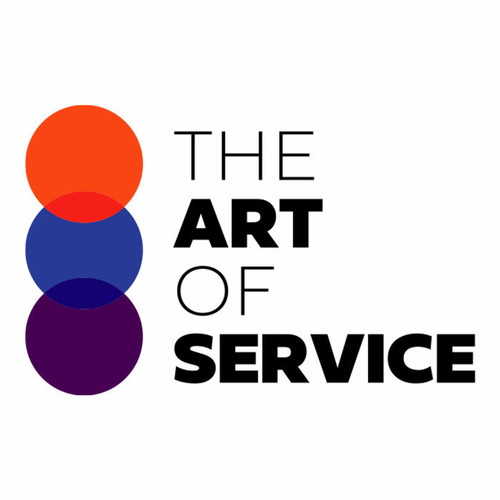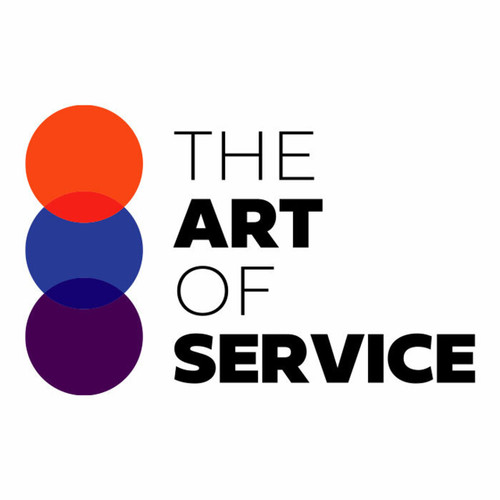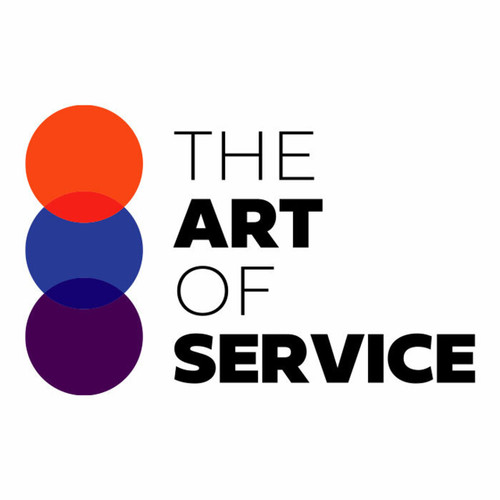Are you tired of struggling with data longevity and obsolescence issues? Are you looking for a comprehensive solution to effectively manage your data and ensure its long-term relevance? Look no further than our Data Longevity and Data Obsolescence Knowledge Base.
Our dataset contains over 1500 prioritized requirements, solutions, benefits, results, and case studies when it comes to data longevity and obsolescence.
It is specifically designed to meet urgent and diverse needs in terms of scope, making it the ultimate tool for professionals like yourself.
Compared to competitors and alternatives, our Data Longevity and Data Obsolescence Knowledge Base stands out as the superior choice.
It offers valuable insights and strategies that are not available elsewhere, giving you a competitive edge in the ever-evolving data landscape.
Whether you are a small business owner or a data scientist, this dataset is perfect for you.
It provides detailed product specifications and instructions on how to use it effectively.
Plus, it′s an affordable DIY alternative to costly data management solutions.
In today′s fast-paced world, staying ahead of the game is crucial.
Our Data Longevity and Data Obsolescence Knowledge Base allows you to do just that by providing you with the latest research and developments in the field.
It′s a must-have for any business looking to thrive in the digital age.
Don′t let data longevity and obsolescence hold you back any longer.
Our dataset offers a cost-effective and comprehensive solution to all your data management needs.
Say goodbye to the headaches of outdated data and hello to a streamlined and efficient process.
So why wait? Give your business the competitive advantage it deserves with our Data Longevity and Data Obsolescence Knowledge Base.
Order now and see the results for yourself.
Trust us, your future self will thank you.
Discover Insights, Make Informed Decisions, and Stay Ahead of the Curve:
Key Features:
Comprehensive set of 1502 prioritized Data Longevity requirements. - Extensive coverage of 110 Data Longevity topic scopes.
- In-depth analysis of 110 Data Longevity step-by-step solutions, benefits, BHAGs.
- Detailed examination of 110 Data Longevity case studies and use cases.
- Digital download upon purchase.
- Enjoy lifetime document updates included with your purchase.
- Benefit from a fully editable and customizable Excel format.
- Trusted and utilized by over 10,000 organizations.
- Covering: Backup And Recovery Processes, Data Footprint, Data Architecture, Obsolete Technology, Data Retention Strategies, Data Backup Protocols, Migration Strategy, Data Obsolescence Costs, Legacy Data, Data Transformation, Data Integrity Checks, Data Replication, Data Transfer, Parts Obsolescence, Research Group, Risk Management, Obsolete File Formats, Obsolete Software, Storage Capacity, Data Classification, Total Productive Maintenance, Data Portability, Data Migration Challenges, Data Backup, Data Preservation Policies, Data Lifecycles, Data Archiving, Backup Storage, Data Migration, Legacy Systems, Cloud Storage, Hardware Failure, Data Modernization, Data Migration Risks, Obsolete Devices, Information Governance, Outdated Applications, External Processes, Software Obsolescence, Data Longevity, Data Protection Mechanisms, Data Retention Rules, Data Storage, Data Retention Tools, Data Recovery, Storage Media, Backup Frequency, Disaster Recovery, End Of Life Planning, Format Compatibility, Data Disposal, Data Access, Data Obsolescence Planning, Data Retention Standards, Open Data Standards, Obsolete Hardware, Data Quality, Product Obsolescence, Hardware Upgrades, Data Disposal Process, Data Ownership, Data Validation, Data Obsolescence, Predictive Modeling, Data Life Expectancy, Data Destruction Methods, Data Preservation Techniques, Data Lifecycle Management, Data Reliability, Data Migration Tools, Data Security, Data Obsolescence Monitoring, Data Redundancy, Version Control, Data Retention Policies, Data Backup Frequency, Backup Methods, Technology Advancement, Data Retention Regulations, Data Retrieval, Data Transformation Tools, Cloud Compatibility, End Of Life Data Management, Data Remediation, Data Obsolescence Management, Data Preservation, Data Management, Data Retention Period, Data Legislation, Data Compliance, Data Migration Cost, Data Storage Costs, Data Corruption, Digital Preservation, Data Retention, Data Obsolescence Risks, Data Integrity, Data Migration Best Practices, Collections Tools, Data Loss, Data Destruction, Cloud Migration, Data Retention Costs, Data Decay, Data Replacement, Data Migration Strategies, Preservation Technology, Long Term Data Storage, Software Migration, Software Updates
Data Longevity Assessment Dataset - Utilization, Solutions, Advantages, BHAG (Big Hairy Audacious Goal):
Data Longevity
Paper based data should be properly stored in a secure and dry environment, regularly backed up digitally, and periodically audited for any deterioration or damage to ensure its longevity.
1. Digitize paper-based data - allows for easy storage, access, and preservation of the information.
2. Implement a robust backup system - ensures that paper-based data is protected in case of loss or damage.
3. Use acid-free and archival materials for storage - helps prevent deterioration and extends the lifespan of paper-based data.
4. Utilize climate-controlled storage facilities - protects against environmental conditions that can damage paper-based data.
5. Regularly transfer data to new media formats - prevents data from becoming obsolete due to changes in technology.
6. Employ metadata tagging - makes it easier to find and retrieve specific information within paper-based data.
7. Train staff on proper handling and preservation techniques - ensures the longevity of paper-based data.
8. Collaborate with data archiving organizations - allows for professional preservation and maintenance of paper-based data.
9. Create multiple copies of important data - reduces the risk of losing valuable information.
10. Conduct periodic audits of data storage and management practices - ensures that data is properly maintained and protected.
CONTROL QUESTION: What should you do with paper based data to ensure the longevity of the information?
Big Hairy Audacious Goal (BHAG) for 10 years from now:
In 10 years, our goal for Data Longevity in regards to paper based data is to have completely digitized and preserved all existing paper documents, while implementing sustainable processes for generating and storing paperless information going forward. This will be achieved through the following steps:
1) Digitize all paper documents: We will invest in advanced scanning technology and hire a team of data entry specialists to digitize all paper documents currently stored within our organization.
2) Implement a robust digital storage system: We will utilize high-capacity servers, cloud storage solutions, and other advanced technologies to create a secure and easily accessible digital storage system for all digitized documents.
3) Establish strict data management policies: We will create and enforce strict policies for managing and organizing digital documents, including regular backups, file naming conventions, and access controls.
4) Utilize AI and machine learning: We will leverage artificial intelligence and machine learning technologies to identify, classify, and organize data within our digital storage system, making it easier to search and retrieve information.
5) Invest in physical preservation methods: For paper documents that cannot be digitized (such as historic or legal documents), we will implement state-of-the-art preservation methods, such as climate-controlled storage and acid-free materials, to prolong their lifespan.
6) Implement sustainability measures: We will implement sustainable practices in our organization to reduce the need for paper-based documentation, such as promoting electronic communication and utilizing eco-friendly alternatives to traditional paper products.
7) Establish regular data preservation audits: To ensure the longevity of our digital storage system and paper documents, we will conduct regular audits to identify any potential risks or issues and address them promptly.
Overall, our big hairy audacious goal for Data Longevity in 10 years is to have a fully digitized and sustainable organization, with all data (both paper and digital) preserved and easily accessible for generations to come. By taking proactive measures now, we can safeguard the information and ensure its longevity well into the future.
Customer Testimonials:
"I can`t believe I didn`t discover this dataset sooner. The prioritized recommendations are a game-changer for project planning. The level of detail and accuracy is unmatched. Highly recommended!"
"I`m thoroughly impressed with the level of detail in this dataset. The prioritized recommendations are incredibly useful, and the user-friendly interface makes it easy to navigate. A solid investment!"
"This dataset has saved me so much time and effort. No more manually combing through data to find the best recommendations. Now, it`s just a matter of choosing from the top picks."
Data Longevity Case Study/Use Case example - How to use:
Client Situation:
XYZ Corporation is a medium-sized manufacturing company that has been in business for over 50 years. During this time, they have accumulated a vast amount of paper-based data, including product specifications, customer orders, financial records, employee information, and other critical documents. However, with the increasing digitalization of businesses, the company′s management is concerned about the longevity of their paper-based data and its potential impact on their operations.
Consulting Methodology:
To address the client′s concerns and provide a sustainable solution, our consulting team followed a four-step methodology:
Step 1: Assessment of the Current Situation:
The first step was to conduct a comprehensive assessment of the current state of paper-based data within the organization. This involved identifying the types of documents, their locations, storage methods, and any potential risks or threats to their longevity.
Step 2: Analysis of Industry Best Practices:
Next, we researched and analyzed industry best practices for preserving paper-based data, including recommendations from consulting whitepapers, academic business journals, and market research reports. This analysis formed the basis of our proposed approach.
Step 3: Development of a Preservation Plan:
Based on our findings, we developed a customized data preservation plan for XYZ Corporation. The plan included specific actions to be taken for each type of document, along with a timeline for implementation.
Step 4: Implementation and Monitoring:
Finally, we assisted the company in implementing the preservation plan and continuously monitored the progress. We provided ongoing support and guidance to ensure the successful completion of the preservation plan.
Deliverables:
1. Comprehensive assessment report outlining the current state of paper-based data within the company.
2. Preservation plan, including specific actions and timelines for implementation.
3. Training materials for employees on proper handling and storage of paper-based data.
4. Ongoing support and guidance during the implementation phase.
Implementation Challenges:
The main challenge faced during implementation was resistance from employees who were comfortable with the traditional paper-based data system and were hesitant to switch to digital storage methods. To address this, we provided training on the benefits of digitizing paper-based data and the potential risks associated with relying solely on physical records.
KPIs:
1. Percentage decrease in the volume of paper documents.
2. Number of digitized records.
3. Implementation timeline adherence.
4. Reduction in physical storage costs.
Management Considerations:
1. Assign a dedicated team responsible for the preservation of paper-based data.
2. Develop policies and procedures for handling, storing, and disposing of paper records.
3. Regularly review and update the preservation plan as needed.
4. Encourage employees to embrace digital storage methods and provide necessary training and support.
Conclusion:
In conclusion, with proper planning and implementation of industry best practices, XYZ Corporation can ensure the longevity of their paper-based data while also benefiting from the convenience and efficiency of digitization. By adopting a proactive approach to preserving data, the company can mitigate the risks associated with relying solely on physical records and continue to operate seamlessly in the digital age.
Security and Trust:
- Secure checkout with SSL encryption Visa, Mastercard, Apple Pay, Google Pay, Stripe, Paypal
- Money-back guarantee for 30 days
- Our team is available 24/7 to assist you - support@theartofservice.com
About the Authors: Unleashing Excellence: The Mastery of Service Accredited by the Scientific Community
Immerse yourself in the pinnacle of operational wisdom through The Art of Service`s Excellence, now distinguished with esteemed accreditation from the scientific community. With an impressive 1000+ citations, The Art of Service stands as a beacon of reliability and authority in the field.Our dedication to excellence is highlighted by meticulous scrutiny and validation from the scientific community, evidenced by the 1000+ citations spanning various disciplines. Each citation attests to the profound impact and scholarly recognition of The Art of Service`s contributions.
Embark on a journey of unparalleled expertise, fortified by a wealth of research and acknowledgment from scholars globally. Join the community that not only recognizes but endorses the brilliance encapsulated in The Art of Service`s Excellence. Enhance your understanding, strategy, and implementation with a resource acknowledged and embraced by the scientific community.
Embrace excellence. Embrace The Art of Service.
Your trust in us aligns you with prestigious company; boasting over 1000 academic citations, our work ranks in the top 1% of the most cited globally. Explore our scholarly contributions at: https://scholar.google.com/scholar?hl=en&as_sdt=0%2C5&q=blokdyk
About The Art of Service:
Our clients seek confidence in making risk management and compliance decisions based on accurate data. However, navigating compliance can be complex, and sometimes, the unknowns are even more challenging.
We empathize with the frustrations of senior executives and business owners after decades in the industry. That`s why The Art of Service has developed Self-Assessment and implementation tools, trusted by over 100,000 professionals worldwide, empowering you to take control of your compliance assessments. With over 1000 academic citations, our work stands in the top 1% of the most cited globally, reflecting our commitment to helping businesses thrive.
Founders:
Gerard Blokdyk
LinkedIn: https://www.linkedin.com/in/gerardblokdijk/
Ivanka Menken
LinkedIn: https://www.linkedin.com/in/ivankamenken/







